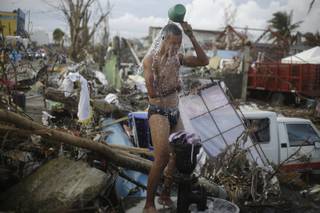
ASSOCIATED PRESS
A young boy hides from the rain while waiting for an evacuation flight at the airport in Tacloban, central Philippines, Thursday, Nov. 14, 2013.
Wednesday, Nov. 13, 2013 | 11:41 p.m.
TACLOBAN, Philippines — A city devastated by last week's typhoon buried some of its dead in a mass grave in a hillside cemetery on Thursday, a somber reminder of the tragedy that has left the Philippines with the monumental task of providing for some 11.5 million affected people.
Aid was beginning to reach some of the 545,000 people displaced by Typhoon Haiyan that tore across several islands in eastern Philippines six days ago, killing thousands of people. Most of the casualties occurred in Leyte province, its capital Tacloban, and Samar island. Many bodies are still lying along the roads in the city and others are buried under debris.
Outside the Tacloban City Hall, dozens of bodies in bags were lined up Thursday, awaiting burial. The stench of death filled the air.
In the first such operation, 30 bodies in leaking black bags were lowered into graves just outside the city. No prayers were said.
"I hope this is the last time I see something like this," said Mayor Alfred Romualdez. "When I look at this it just reminds me of what has happened from the day the storm hit until today."
Officials said efforts had been made to identify the bodies so families have a chance of finding out what happened to their loved ones in the days and weeks to come, but it was not immediately clear whether this included DNA testing.
Authorities say 2,357 people have been confirmed dead in the disaster, but that figure is expected to rise, perhaps significantly, when information is collected from other areas of the disaster zone.
Valerie Amos, the U.N. humanitarian chief who toured Tacloban on Wednesday, said some 11.5 million people have been affected by the typhoon, which includes people who lost their loved ones, were injured, suffered damage to their homes, business or livelihoods.
"The typhoon hit without discrimination ... the situation is dismal," she said in a statement.
Talking to reporters in Manila on Thursday, she said the immediate priority for humanitarian agencies over the next few days is to transport and distribute high energy biscuits and other food, tarpaulins, tents, clean drinking water and basic sanitation services.
"I think we are all extremely distressed that this is Day 6 and we have not managed to reach everyone," she said.
Along with aid workers, Philippine soldiers on trucks were distributing rice and water. Chainsaw-wielding teams cut debris from blocked roads, as thousands swarmed the airport, desperate to leave.
The first nighttime flights — of C-130 transport planes — arrived since the typhoon struck, suggesting air control systems are now in place for a 24-7 operation — a prerequisite for the massive relief operation needed.
While there is no shortage of aid material — both domestic and international — much of it is stuck in Manila and the nearby airport of Cebu because of the extensive damage that Tacloban airport suffered. Some of it, including food, water and medical supplies from the U.S., Malaysia and Singapore, had reached Tacloban and sat on pallets along the tarmac.
Amos said because of a lack of fuel in Tacloban, the few trucks on ground are unable to move the aid material from the airport to the city. The weather also remains a challenge, with frequent downpours. The good news is that the debris on the road from the airport to the city has been pushed to one side, she said.
On Wednesday, the U.N.'s World Food Program distributed rice and other items to nearly 50,000 people in the Tacloban area. Nearly 10 tons of high energy biscuits were also delivered to the city on Wednesday, with another 25 tons on the way.
The Tacloban airport has also become the site of a makeshift clinic where hundreds of injured people, pregnant women, children and the elderly have poured in. The run-down, single-story building with filthy floors has little medicine, virtually no facilities and very few doctors.
Doctors who have been dealing with cuts, fractures and pregnancy complications said Wednesday they soon expect to be treating more serious problems such as pneumonia, dehydration, diarrhea and infections from lack of clean water.
Some among the desperate residents have resorted to raiding for food. Mobs overran a rice warehouse on Leyte, collapsing a wall that killed eight people. Thousands of sacks of the grain were carted off. But police say the situation is improving on the ground, and there was little sign Thursday of a deteriorating security situation there.
Philippine Energy Secretary Jericho Petilla said it may take six weeks before the first typhoon-hit towns get their electric power back. He said that in Tacloban, order needed to be restored "because if there's no peace and order, it's hard to reinstall the power posts."
He said army troops had fired shots Wednesday to drive away a group of armed men who approached a power transmission sub-station in Leyte province. The unidentified men fired back then fled. Nobody was hurt.
AP writers Todd Pitman in Tacloban and Chris Brummitt and Teresa Cerojano in Manila contributed to this report.


Join the Discussion:
Check this out for a full explanation of our conversion to the LiveFyre commenting system and instructions on how to sign up for an account.
Full comments policy